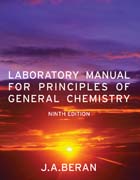
This new edition of the Beran lab manual emphasises chemical principles as well as techniques. The manual helps students understand the timing and situations for the various techniques. The Beran lab manual has long been a market leading lab manual for general chemistry. Each experiment is presented with concise objectives, a comprehensive list of techniques, and detailed lab intros andstep-by-step procedures INDICE: "Preface. Photo Credits. Laboratory Safety and Guidelines. Laboratory Data. Laboratory Techniques. Experiments. A. Introduction. Dry Lab 1 The Laboratory and SI. Experiment 1 Basic Laboratory Operations. B. Chemical and Physical Properties. Experiment 2 Identification of a Compound: Chemical Properties. Experiment 3 Water Analysis: Solids. Experiment 4 Paper Chromatography. Experiment 5 Percent Water in a Hydrated Salt. Dry Lab 2A Inorganic Nomenclature I. Oxidation Numbers. Dry Lab 2B Inorganic Nomenclature II. Binary Compounds. Dry Lab 2C Inorganic Nomenclature III. Ternary Compounds. Experiment 6 Acids, Bases, and Salts. C. Mole Concept. Experiment 7 Empirical Formulas. Experiment 8 Limiting Reactant. Experiment 9 A Volumetric Analysis. Experiment 10 Vinegar Analysis. D. Atomic and Molecular Structure. Experiment 11 Periodic Table and Periodic Law. Dry Lab 3 Atomic and Molecular Structure. E. Gases. Experiment 12 Molar Mass of a Volatile Liquid. Experiment 13 A Carbonate Analysis; Molar. Volume of Carbon Dioxide. F. Solutions. Experiment 14 Molar Mass of a Solid. Experiment 15 Synthesis of Potassium Alum. G. Acid-Base Equilibria and Analysis. Experiment 16 LeChâtelier's Principle; Buffers. Experiment 17 Antacid Analysis. Experiment 18 Potentiometric Analyses. Experiment 19 Aspirin Synthesisand Analysis. Experiment 20 Alkalinity of a Water Resource. Experiment 21 Hard Water Analysis. Experiment 22 Molar Solubility; Common-Ion Effect. H. Kinetics. Experiment 23 Factors Affecting Reaction Rates. Experiment 24 A Rate Law and Activation Energy. I. Thermodynamics. Experiment 25 Calorimetry. Experiment26 Thermodynamics of the Dissolution of Borax. J. Oxidation-Reduction Systemsand Analysis. Experiment 27 Oxidation-Reduction Reactions. Experiment 28 Chemistry of Copper. Experiment 29 Bleach Analysis. Experiment 30 Vitamin C Analysis. Experiment 31 Dissolved Oxygen Levels in Natural Waters. Experiment 32 Galvanic Cells, the Nernst Equation. Experiment 33 Electrolytic Cells, Avogadro'sNumber. K. Transition Metal Systems and Analysis. Experiment 34 An Equilibrium Constant. Experiment 35 Spectrophotometric Metal Ion Analysis. Experiment 36Transition Metal Complexes. L. Qualitative Analysis. Dry Lab 4 Preface to Qualitative Analysis. Experiment 37 Qual: Common Anions. Experiment 38 Qual I. Na_, K_, , Mg2_, Ca2_, Cu2. Experiment 39 Qual II. Ni2_, Fe3_, Al3_, Zn2_,. Appendixes. Appendix A Conversion Factors. Appendix B Treatment of Data. Appendix C Graphing Data. Appendix D Familiar Names of Common Chemicals. Appendix E Vapor Pressure of Water. Appendix F Concentrations of Acids and Bases. Appendix GWater Solubility of Inorganic Salts. Laboratory Manual for Principles of General Chemistry."
- ISBN: 978-0-470-64789-9
- Editorial: John Wiley & Sons
- Encuadernacion: Rústica
- Páginas: 464
- Fecha Publicación: 11/11/2010
- Nº Volúmenes: 1
- Idioma: Inglés
